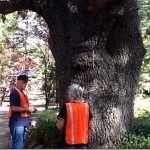As we continue with another Southern California winter, are we all asking, “Where is this El Nino?”
Who does not enjoy sitting, relaxing or working on a project outdoors on your deck when great weather is offered up?
One thing that is common around the mountain community is the number of homes with decks built into or added on to them. Most houses, which are constructed off the Hill in suburbia or the “flatlands,” tend to have concrete patios in a backyard; but our area is different.
The hills, steep slopes and building of multi-story construction that takes advantage of many spectacular views adds to the allure of decks.
Decks, similar to most things, require a certain amount of maintenance to prolong their life. Besides the usual painting, staining or oiling to maintain your deck, ask yourself, if your deck — and the area around and under it — is best prepared for exposure to a fire.
Keeping the deck surface clear of pine needles and leaves is an obvious task. This same attention should be given to the accessible area under decks. This material is a great ignition source for hot, wind-blown embers and firebrands, which are burning materials produced by a wildfire and carried ahead of the advancing fire.
While storage in and around mountain structures is often limited, don’t let that open space under a deck become the convenient catchall location for combustible material, such as cardboard boxes, lumber and firewood.
If you store firewood, be sure to keep it away from the house to prevent embers from igniting it and cover it with a tarp.
Because many decks are built to service an elevated first floor and often second-story openings, it is necessary to pay attention to the growth of vegetation, brush and trees on a slope below the deck. Consideration of how this material, if burning, would spread upward toward the structure or overhanging deck is crucial when planning to thin and perform fire abatement on this slope.
Slope plays a large part in the behavior of fire. As fire at the lower portion of a slope burns, it preheats vegetative and other material ahead of it, which moves fire along at a rapid rate.
Try this yourself over the kitchen sink by holding a lit match upright, now hold it horizontal. It might burn slightly faster but you can still hold it. Tilt the head
of the burning match at an angle below your fingers and notice how quickly the heat and the flame find your fingertips.
This burning of lower fuels that spreads to higher fuels such as tree branches is called ladder fuels. An example of ladder fuels could be wood piles, storage of combustible materials, brush or a fence next to your home or overhanging deck that allows a fire to continue on its path to your structure. This problem can be corrected by providing a separation between the vegetation layers or a mosaic look.
Getting started on this simple task to provide yourself some defensible space and added protection for your deck and home will be worth the enjoyment you get later in the year.
Call the Mountain Communities Fire Safe Council office at 951-659-6208 and have our project manager help you determine how to better protect your property.










